2012 Hyundai H-100 Truck hood open
[x] Cancel search: hood openPage 42 of 217
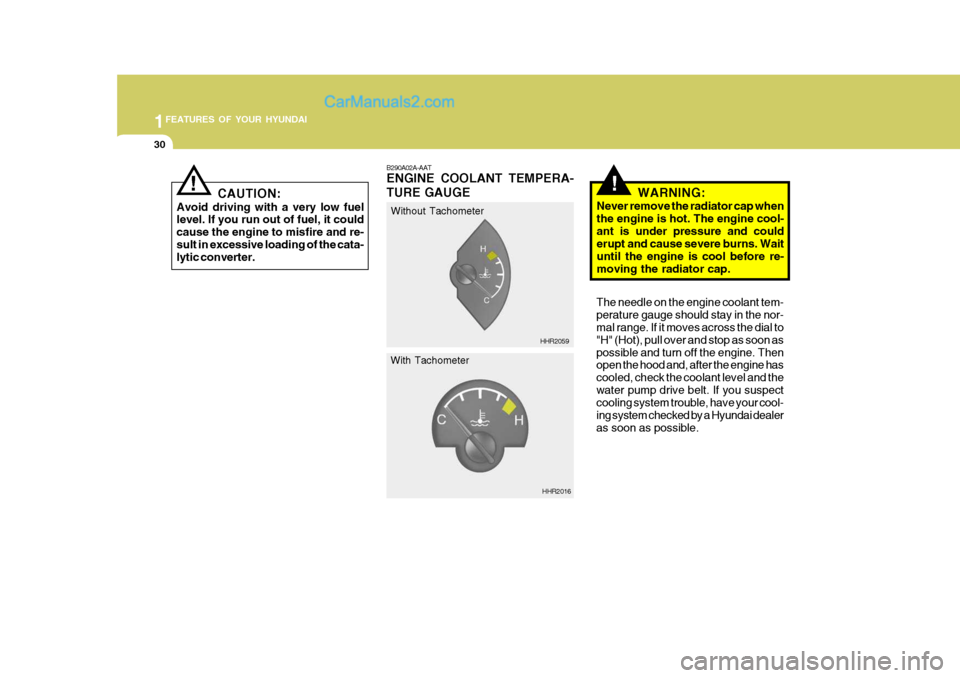
1FEATURES OF YOUR HYUNDAI
30
!
B290A02A-AAT ENGINE COOLANT TEMPERA- TURE GAUGE
WARNING:
Never remove the radiator cap when the engine is hot. The engine cool-ant is under pressure and could erupt and cause severe burns. Wait until the engine is cool before re-moving the radiator cap.
The needle on the engine coolant tem-perature gauge should stay in the nor-mal range. If it moves across the dial to "H" (Hot), pull over and stop as soon as possible and turn off the engine. Then open the hood and, after the engine has cooled, check the coolant level and thewater pump drive belt. If you suspect cooling system trouble, have your cool- ing system checked by a Hyundai dealeras soon as possible.
HHR2059
HHR2016
Without Tachometer
With Tachometer
CAUTION:
Avoid driving with a very low fuel level. If you run out of fuel, it could cause the engine to misfire and re-sult in excessive loading of the cata- lytic converter.
!
Page 59 of 217

1
FEATURES OF YOUR HYUNDAI
47HOOD RELEASE
B570A01HR-GAT
1. Pull the release knob to unlatch the hood. B570B01HR
B570A01HR
Releasing the parking brake To release the parking brake, first apply the foot brake and pull the parking brake lever slightly. Secondly, depress therelease button and lower the parking brake lever while holding the button. CAUTION:
o Driving with the parking brake ap- plied will cause excessive brake pad (or lining) and brake rotor wear.
o Do not operate the parking brake while the vehicle is moving exceptin an emergency situation. It could damage the vehicle system andmake endanger driving safety.
!
!WARNING:
Open the hood after turning off the engine on a flat surface, shifting theshift lever to the 1st(First) gear or R(Reverse) for manual transaxle, and setting the parking brake. 2. Push the secondary latch lever to
the left and lower the hood.
To close the hood, lift up it and hit thecenter of the hood with your hand. Makesure that it locks into place. NOTE: If the hood will not open because ice has formed around it, tap lightly orpush on the hood to break the ice and release the hood. Do not pry on the hood. If necessary, spray aroundthe hood with an approved de-icer fluid (do not use radiator anti-freeze) or move the vehicle to a warm placeand allow the ice to melt.
Page 60 of 217
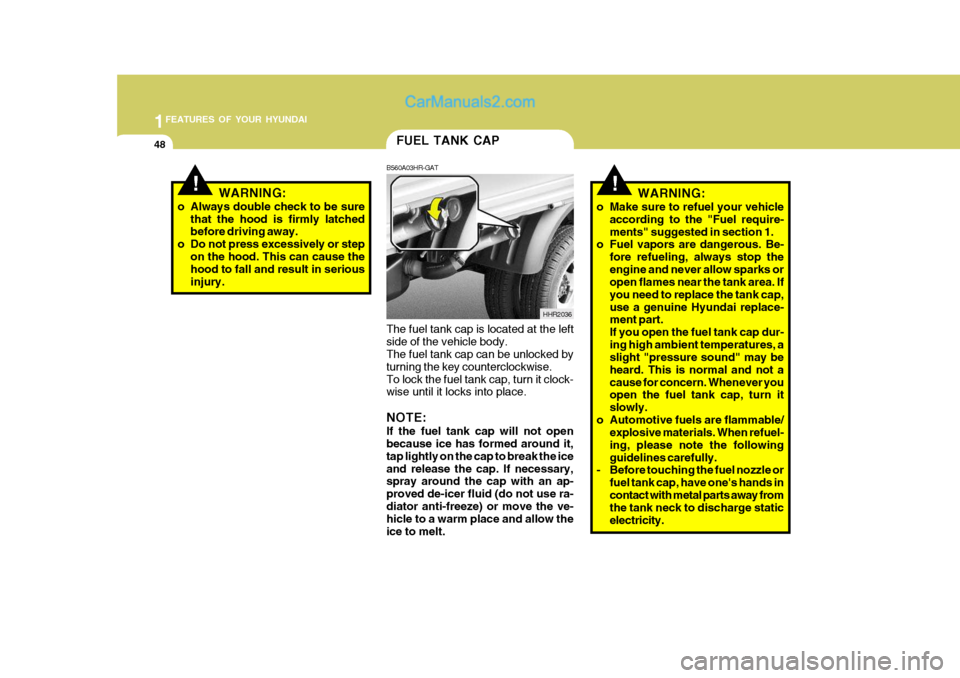
1FEATURES OF YOUR HYUNDAI
48
!WARNING:
o Make sure to refuel your vehicle according to the "Fuel require- ments" suggested in section 1.
o Fuel vapors are dangerous. Be-
fore refueling, always stop theengine and never allow sparks or open flames near the tank area. If you need to replace the tank cap,use a genuine Hyundai replace- ment part. If you open the fuel tank cap dur-ing high ambient temperatures, a slight "pressure sound" may be heard. This is normal and not acause for concern. Whenever you open the fuel tank cap, turn it slowly.
o Automotive fuels are flammable/ explosive materials. When refuel-ing, please note the followingguidelines carefully.
- Before touching the fuel nozzle or
fuel tank cap, have one's hands incontact with metal parts away from the tank neck to discharge static electricity.
FUEL TANK CAP
B560A03HR-GAT
The fuel tank cap is located at the left side of the vehicle body. The fuel tank cap can be unlocked by turning the key counterclockwise.To lock the fuel tank cap, turn it clock- wise until it locks into place. NOTE: If the fuel tank cap will not open because ice has formed around it, tap lightly on the cap to break the iceand release the cap. If necessary, spray around the cap with an ap- proved de-icer fluid (do not use ra-diator anti-freeze) or move the ve- hicle to a warm place and allow the ice to melt. HHR2036
!WARNING:
o Always double check to be sure that the hood is firmly latched before driving away.
o Do not press excessively or step on the hood. This can cause thehood to fall and result in serious injury.
Page 75 of 217
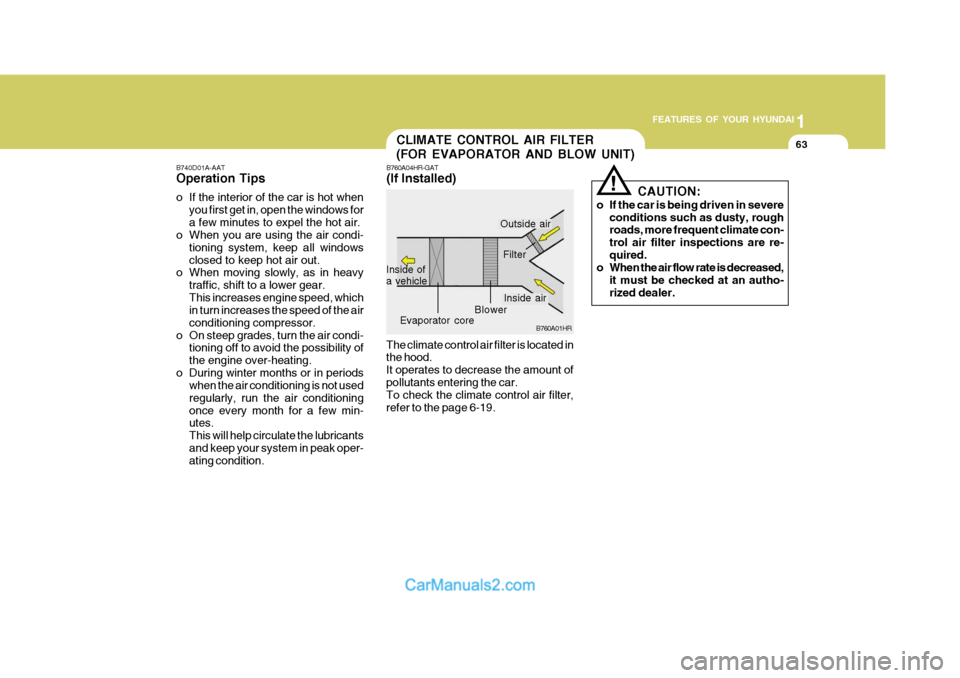
1
FEATURES OF YOUR HYUNDAI
63CLIMATE CONTROL AIR FILTER
(FOR EVAPORATOR AND BLOW UNIT)
B760A01HR
Inside of a vehicle
Evaporator core Filter
Blower
The climate control air filter is located in the hood. It operates to decrease the amount ofpollutants entering the car. To check the climate control air filter, refer to the page 6-19. B760A04HR-GAT (If Installed)
B740D01A-AATOperation Tips
o If the interior of the car is hot when
you first get in, open the windows for a few minutes to expel the hot air.
o When you are using the air condi-
tioning system, keep all windowsclosed to keep hot air out.
o When moving slowly, as in heavy
traffic, shift to a lower gear.This increases engine speed, which in turn increases the speed of the air conditioning compressor.
o On steep grades, turn the air condi- tioning off to avoid the possibility ofthe engine over-heating.
o During winter months or in periods when the air conditioning is not usedregularly, run the air conditioningonce every month for a few min- utes. This will help circulate the lubricantsand keep your system in peak oper- ating condition.
! CAUTION:
o If the car is being driven in severe conditions such as dusty, rough roads, more frequent climate con- trol air filter inspections are re-quired.
o When the air flow rate is decreased,
it must be checked at an autho-rized dealer.
Outside air
Inside air
Page 119 of 217
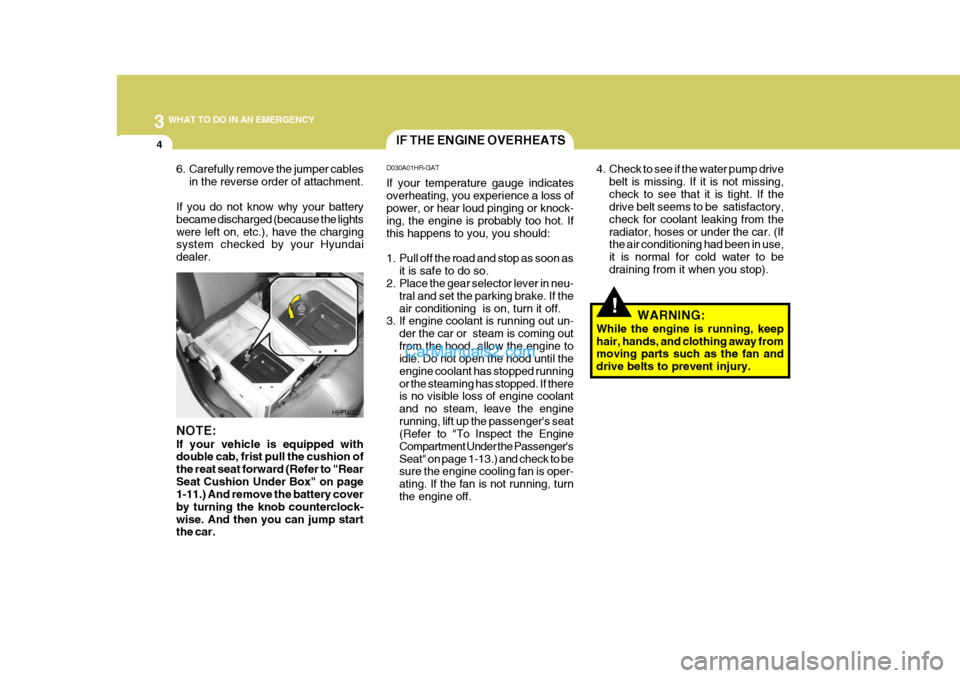
3 WHAT TO DO IN AN EMERGENCY
4
!
IF THE ENGINE OVERHEATS
D030A01HR-GAT If your temperature gauge indicates overheating, you experience a loss of power, or hear loud pinging or knock- ing, the engine is probably too hot. Ifthis happens to you, you should:
1. Pull off the road and stop as soon as it is safe to do so.
2. Place the gear selector lever in neu-
tral and set the parking brake. If the air conditioning is on, turn it off.
3. If engine coolant is running out un-
der the car or steam is coming outfrom the hood, allow the engine to idle. Do not open the hood until the engine coolant has stopped runningor the steaming has stopped. If there is no visible loss of engine coolant and no steam, leave the enginerunning, lift up the passenger's seat
(Refer to "To Inspect the Engine
Compartment Under the Passenger's
Seat" on page 1-13.) and check to be sure the engine cooling fan is oper- ating. If the fan is not running, turnthe engine off.
6. Carefully remove the jumper cables
in the reverse order of attachment.
If you do not know why your batterybecame discharged (because the lightswere left on, etc.), have the charging system checked by your Hyundai dealer. 4. Check to see if the water pump drive
belt is missing. If it is not missing,check to see that it is tight. If the drive belt seems to be satisfactory, check for coolant leaking from theradiator, hoses or under the car. (If the air conditioning had been in use, it is normal for cold water to bedraining from it when you stop).
WARNING:
While the engine is running, keephair, hands, and clothing away from moving parts such as the fan and drive belts to prevent injury.
HHR4002
NOTE: If your vehicle is equipped with double cab, frist pull the cushion of the reat seat forward (Refer to "RearSeat Cushion Under Box" on page 1-11.) And remove the battery cover by turning the knob counterclock-wise. And then you can jump start the car.
Page 154 of 217
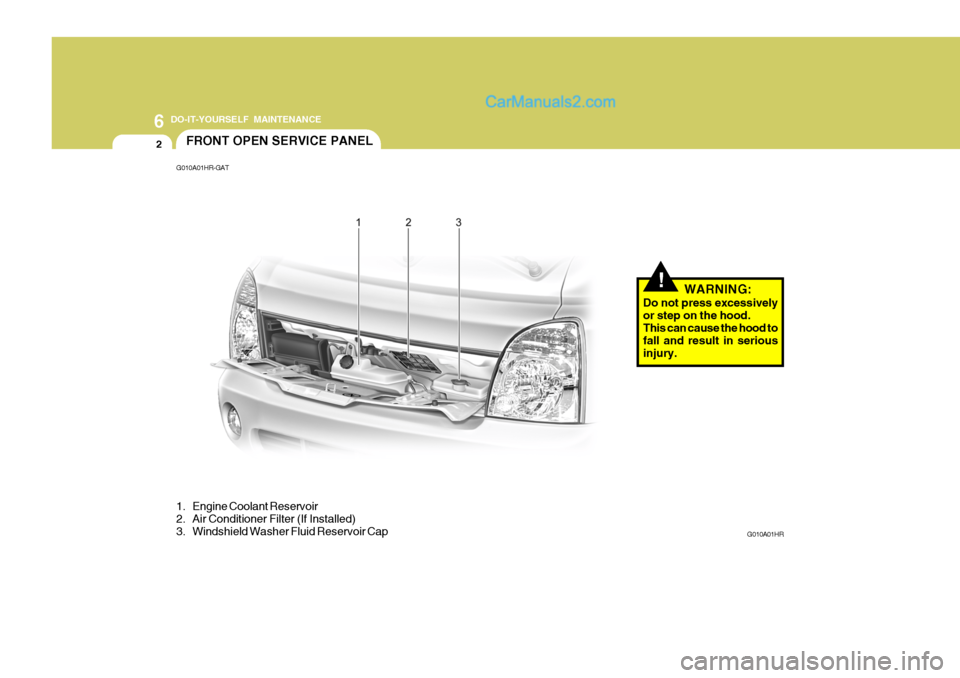
6 DO-IT-YOURSELF MAINTENANCE
2
!
FRONT OPEN SERVICE PANEL
G010A01HR-GAT
1. Engine Coolant Reservoir
2. Air Conditioner Filter (If Installed)
3. Windshield Washer Fluid Reservoir Cap G010A01HR
WARNING:
Do not press excessivelyor step on the hood. This can cause the hood to fall and result in seriousinjury.
Page 164 of 217
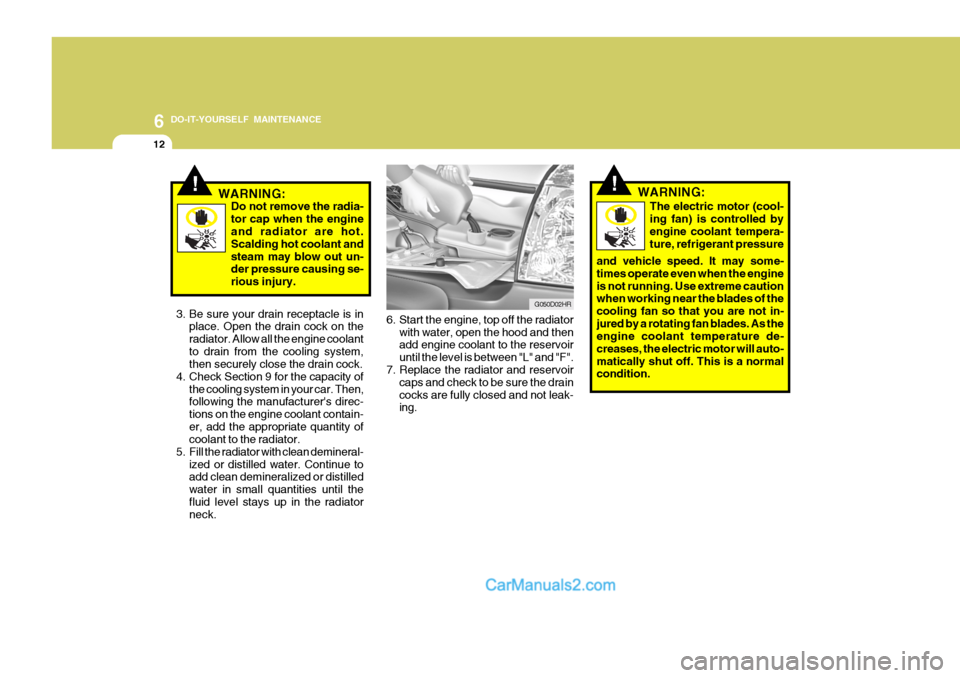
6 DO-IT-YOURSELF MAINTENANCE
12
!WARNING:
6. Start the engine, top off the radiator with water, open the hood and then add engine coolant to the reservoir until the level is between "L" and "F".
7. Replace the radiator and reservoir
caps and check to be sure the draincocks are fully closed and not leak- ing.
3. Be sure your drain receptacle is inplace. Open the drain cock on the radiator. Allow all the engine coolantto drain from the cooling system, then securely close the drain cock.
4. Check Section 9 for the capacity of
the cooling system in your car. Then,following the manufacturer's direc- tions on the engine coolant contain-er, add the appropriate quantity of coolant to the radiator.
5. Fill the radiator with clean demineral-
ized or distilled water. Continue toadd clean demineralized or distilled water in small quantities until thefluid level stays up in the radiator neck. G050D02HR
!WARNING:
Do not remove the radia- tor cap when the engine and radiator are hot. Scalding hot coolant andsteam may blow out un- der pressure causing se- rious injury.The electric motor (cool- ing fan) is controlled by engine coolant tempera- ture, refrigerant pressure
and vehicle speed. It may some-times operate even when the engineis not running. Use extreme caution when working near the blades of the cooling fan so that you are not in-jured by a rotating fan blades. As the engine coolant temperature de- creases, the electric motor will auto-matically shut off. This is a normal condition.
Page 172 of 217
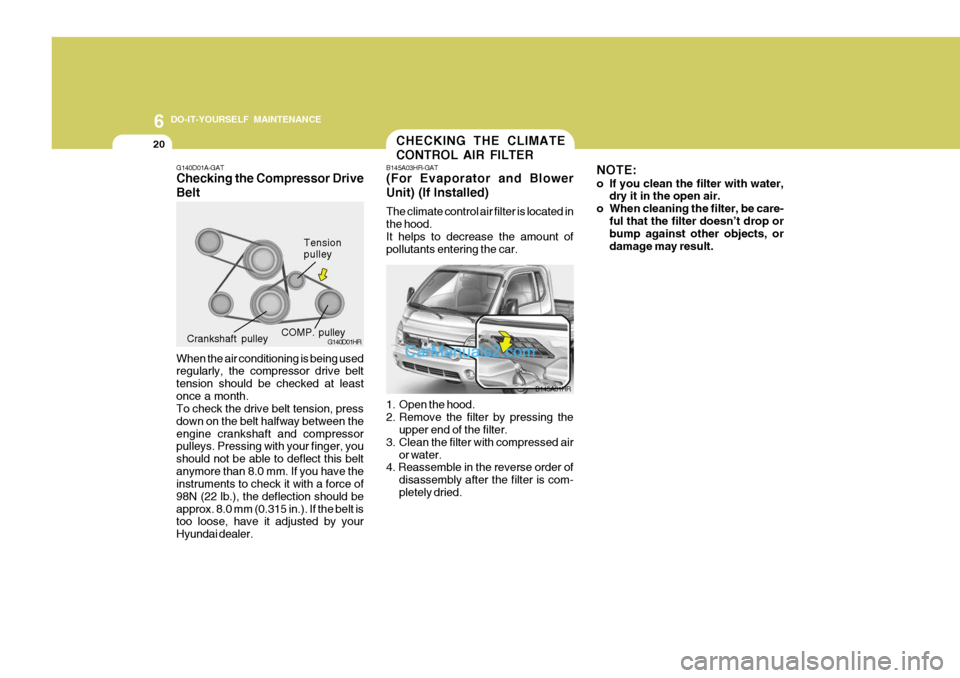
6 DO-IT-YOURSELF MAINTENANCE
20
NOTE:
o If you clean the filter with water,dry it in the open air.
o When cleaning the filter, be care- ful that the filter doesn’t drop or bump against other objects, or damage may result.
Crankshaft pulley
G140D01A-GAT Checking the Compressor Drive Belt When the air conditioning is being used regularly, the compressor drive belt tension should be checked at leastonce a month. To check the drive belt tension, press down on the belt halfway between theengine crankshaft and compressor pulleys. Pressing with your finger, you should not be able to deflect this beltanymore than 8.0 mm. If you have the instruments to check it with a force of 98N (22 lb.), the deflection should beapprox. 8.0 mm (0.315 in.). If the belt is too loose, have it adjusted by your Hyundai dealer. G140D01HRCOMP. pulley
Tension pulley
CHECKING THE CLIMATE CONTROL AIR FILTER
B145A03HR-GAT
(For Evaporator and Blower Unit) (If Installed) The climate control air filter is located in the hood.It helps to decrease the amount of pollutants entering the car.
B145A01HR
1. Open the hood.
2. Remove the filter by pressing the upper end of the filter.
3. Clean the filter with compressed air
or water.
4. Reassemble in the reverse order of
disassembly after the filter is com-pletely dried.